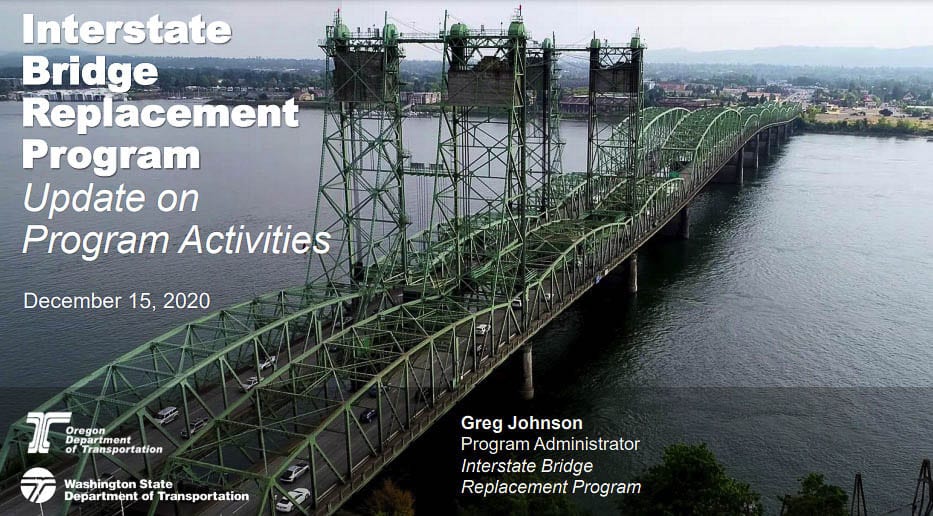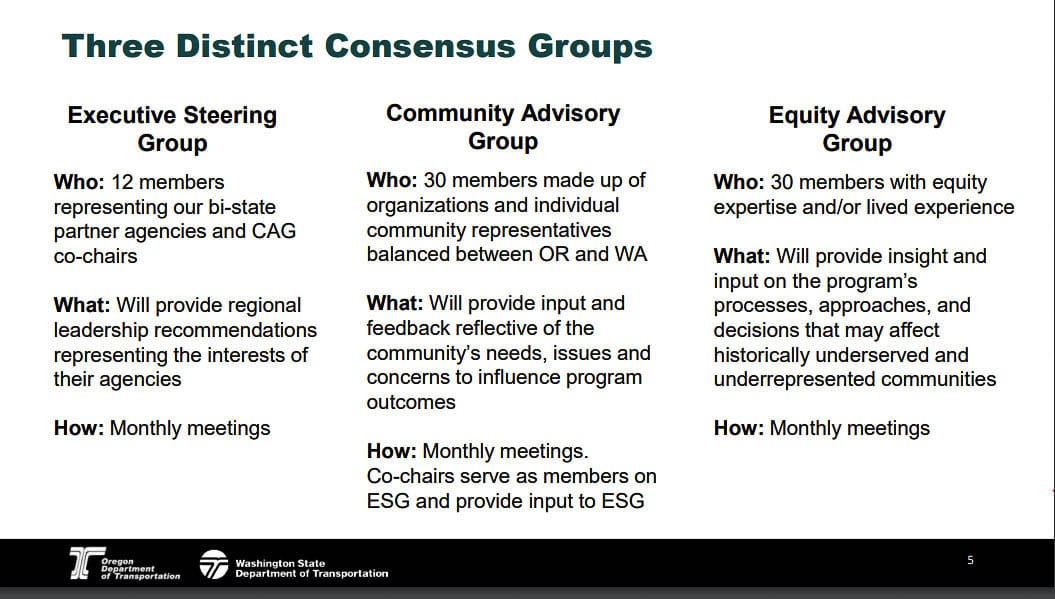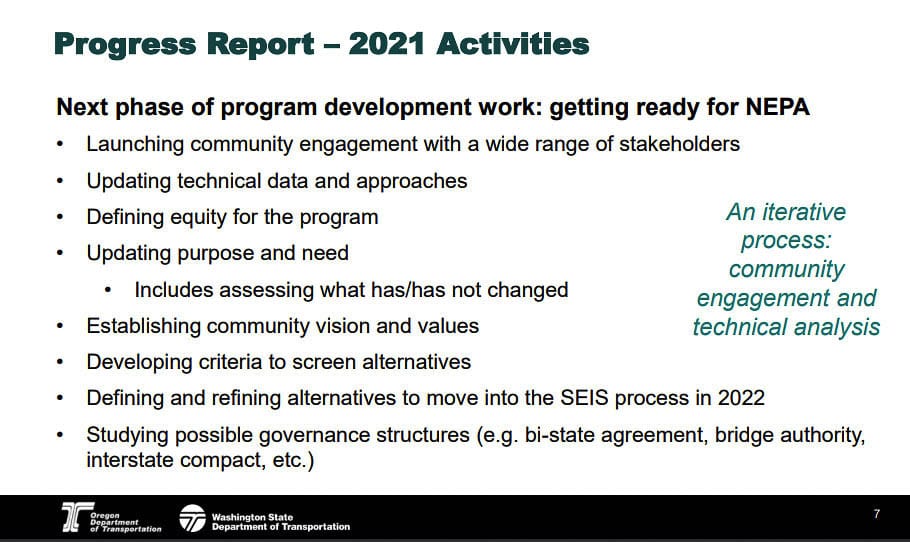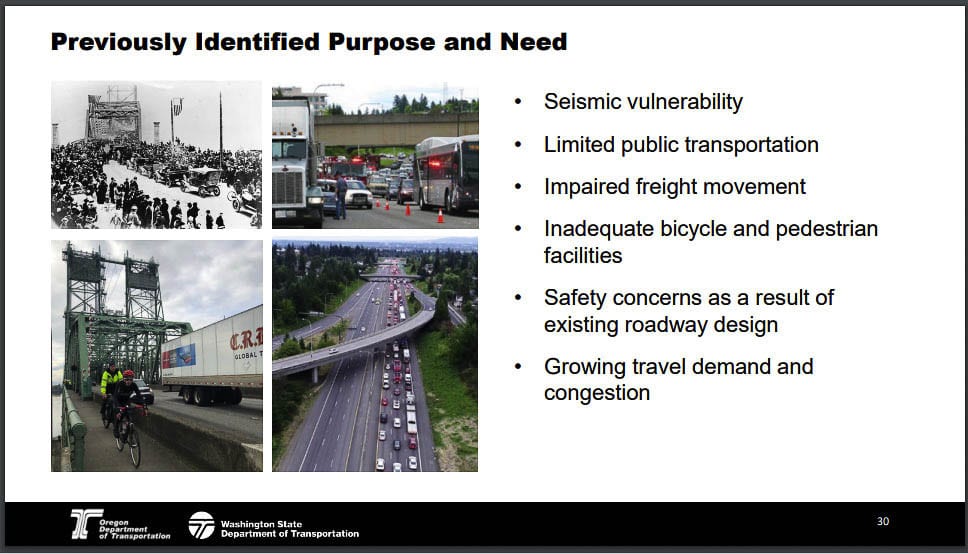Two 30-person community groups to be created for input
The 16 legislative members of the Oregon and Washington Bi-State Bridge Committee met virtually Tuesday. Greg Johnson, administrator of the Interstate Bridge Replacement Project (IBRP) and his staff gave the committee updates on community outreach and the conceptual finance plan.
Early in the meeting, Sen. Lynda Wilson (17th District) asked about the letter released Monday by Congresswoman Jaime Herrera Beutler, asking for a focus on commuters and truckers stuck in bridge traffic.
“We just want to make sure that the right people are at the table,” Wilson said. “Because the majority of this bridge is going to be used by commuters. So we need to make sure that we do have a sufficient amount of these people on board, or down the line we’re going to have the same issues that we had before.”
WIlson later said “we can’t lose sight of the fact that the primary purpose is to serve the commuters and freight haulers.” She listed three primary concerns — commuters, freight mobility, and safety.

Johnson informed the legislators his staff has responded to the Congresswoman and promised to provide a copy of that response to the committee.
Johnson reviewed the timeline going forward. They hope to produce the Purpose and Need, and a Vision and Values statements by this summer. The next major product will be a Draft Supplemental Environmental Impact Statement where various alternatives are evaluated and then narrowed down. That would be drafted in 2022 and published in 2023.
“If we get an approved record of decision and budget agreement from both states, we will immediately move into the pre-construction phase,” said Johnson. That would include buying right of way, moving utilities, doing design work, and getting construction packages set up to begin work in 2025.
Johnson indicated they will get updated traffic counts and origination and destination (O&D) data from the states to see what has and hasn’t changed from the failed Columbia River Crossing (CRC) effort. Those updated traffic counts won’t occur until after the Locally Preferred Alternative (LPA) has been updated. Citizens might wonder why they wouldn’t get current data and travel patterns before modifying the LPA.
“One of the one of the key issues that you will be hearing is because we had a locally preferred alternative approved, the federal government, through Federal Highway Administration and Federal Transit Authority, will be expecting us to address every issue that was brought up and approved as part of the locally preferred alternative,” Johnson said.
“Now that does not limit us to those are the only things that will be in the Purpose and Need,” he said. “But it does mean that we have to go back and look at and say, ‘okay, have those things been addressed by something different that has happened in this time period,’ since the original Purpose and Need was established.”
Citizen Advisory Groups
There have been approximately 200 individuals who have applied to be on the Community Advisory Group (CAG). Johnson said roughly 75 percent indicate they use the bridge at least once a week, with another 30 percent using it daily. He shared that eight positions on the CAG will go to these citizens. The other 22 will go to various business and larger interest groups that have applied.
Johnson also indicated they will create a working group for the Hayden Island community to provide input. He may consider creating a separate working group for commuters, in response to the Congresswoman’s letter and Sen. Wilson’s comment. These would be ad hoc committees to the CAG.
There were over 60 recommendations Johnson received from staff and members of the Executive Steering Group (ESG) to be on the CAG. That will be pared down to 22 individuals to represent the various interest groups from both sides of the river.

Johnson also discussed the Equity Advisory Group (EAG) to allow underserved or underrepresented members of the community to participate. This will be 30 people “with equity expertise and or lived experience, with an interest in assuring equity for underrepresented or historically underrepresented groups,” he said.
“One of the things you will note is that we are very much calling these groups consensus,” said Johnson. “Their power lies in their ability to come together, argue their issues, and bring forth a united set of recommendations to the IBR team. This is a process that allows folks to voice their concerns, their issues. But it also forces folks not to draw hard lines where they can’t find themselves in any solution.”
Regarding community engagement, over 43,000 postcards were sent to people on both sides of the river. They targeted seven zip codes focused around the I-5 Bridge corridor; three on the Vancouver side. There were print ads in six publications, plus a great deal of digital outreach. Communications were translated into six different languages.
That prompted Sen. Wilson to respond. “As we go through this Purpose and Need, and Vision and Values, I think we don’t want to lose sight of the fact that we’re talking about three main things here that are of concern,” she said, referring to traffic congestion and freight mobility, moving commerce and the safety of the bridge.
“We don’t want to get too far off of that message,” she said. “Our main goal is those particular areas. So I hear about all of this, and it just concerns me that we’re not keeping our eye on the ball here with freight mobility and congestion relief and the safety of the bridge.”
Finance Plan update
Ray Maybe briefed the committee on the updated conceptual finance plan. “We believe the conclusion of the work on a conceptual finance plan is a pivot point signifying where CRC ends and IBR begins. The estimates from the previous efforts does not preclude us from analyzing other options such as an immersed tube tunnel or high speed rail.”
“It’s important to note that the conceptual finance plan presents a rough order of magnitude of the funding gap, not a precise estimate of that gap,” Maybe said.
Maybe sought to clarify what was included in the conceptual cost estimates.
The CRC base cost estimates are based on a replacement structure on I-5 across the Columbia River, including a fixed guideway transit and bicycle pedestrian pathway. They also include highway improvements between Marine Drive to the south, and SR 500 to the north.
It includes improvements at five I-5 interchanges — Marine Drive, Hayden Island, SR-14, Mill Plain Boulevard and Fourth Plain Boulevard.

The low capital cost options include seismically retrofitting the North Portland Harbour Bridge, and terminating the transit investments at the Turtle Place Station in Vancouver. The high capital cost options include replacing rather than retrofitting the North Portland Harbour Bridge and extending the northern terminus of the transit to Clark College.
“It’s important to acknowledge again the foundational next step of the program, which includes updating that Purpose and Need and establishing community Vision and Values,” said Maybe. “This work will help shape the range of alternatives that go into the supplemental environmental impact statement and therefore the scope of the program.”
In discussing costs and funding, the committee was reminded of the potential funding gap of $1.8 billion to $2.4 billion. “What that represents is a commitment that this program is going to make moving forward to try to scale the proposed improvements to the potential available funds,” said Frank Green.
Green cited $400 million in federal funds that were part of the original CRC funding plan that should not have been relied upon. “So the program had to shift, still working for a solution that met the Purpose and Need, but had to refine the designs to recognize that we couldn’t account for that potential funding source,” he said.
“We are committed to moving forward to scale the program to still meet the Purpose and Need, but recognizing if the funding is going a certain direction or isn’t likely to be able to fund the full scenario, that’s where the future work with the funding gap really comes into play,” Green said.
That statement emphasizes the importance of the Purpose and Need statement, and also that the IBRP team will design a project to fit the money provided. Green said they will look into a potential phased delivery for construction to align with when funding sources become available.

Rep. Jake Fey (27th District, Tacoma) asked how much inflation had raised the costs of the CRC from 2012. Green said they used a WSDOT inflation number, which was 2.3 percent. That drove cost projections to increase by 60 percent from 2012 to the proposed year of construction.
Wilson asked about the $850 million to $1.3 billion in possible tolling revenue. She cited a five-year decline in traffic counts during the Great Recession, and that traffic is down now due to the pandemic.
Green indicated they would be working closely with Metro and the RTC, plus the ODOT tolling program to get traffic data and information on Oregon’s tolling.. Citizens know the impact of Oregon’s tolling plan will likely be a key factor in traffic diversion, and therefore how much money might be raised to fund a bridge.
During public comment, Bob Ortblad spoke representing the Washington Business Alliance. He wants the project to consider an immersed tunnel. Gothenburg, Sweden is opening a new six-lane immersed tube tunnel. They spent about $225 million and Orblad believes a similar immersed tunnel could be built here for around $1 billion.
“A Columbia River immersed tube tunnel would also eliminate the need for half a mile, elevated concrete viaduct on Hayden Island, and Vancouver,” he said.
Economist Joe Cortright addressed the committee, reminding the legislators that there is no need to repay the federal government the $140 million. (Our story here and here). He also reiterated there is a $1 billion error in the cost estimate or the cost gap in the conceptual finance plan. Finally, he said the real inflation should be 3 percent, not the 2 percent used, and therefore that would widen the funding gap by $600 to $800 million.
The next meeting of the committee will likely be in March.




